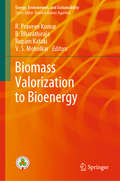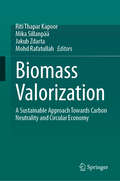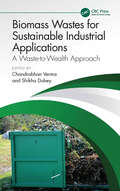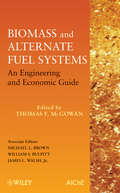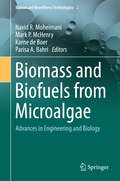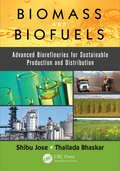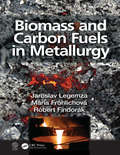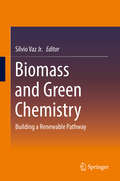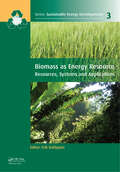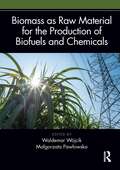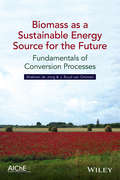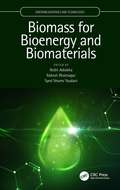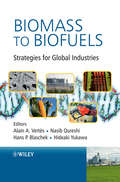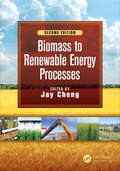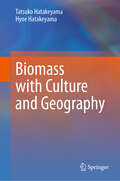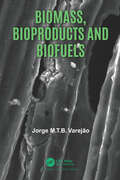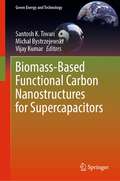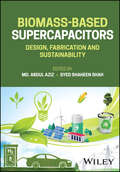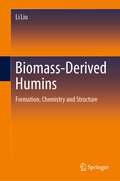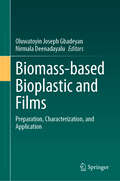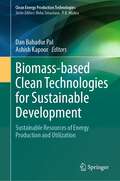- Table View
- List View
Biomass Valorization to Bioenergy (Energy, Environment, and Sustainability)
by R. Praveen Kumar V. S. Moholkar B. Bharathiraja Rupam KatakiThis book covers topics related to bioenergy production from various biomass sources, including agricultural residues and waste biomass from both domestic and industrial use. It includes useful data, illustrations, and case studies of bioenergy production facilities. The contents of this book will be of interest to readers looking to scale up production and evaluate the selection and optimization of resources in order to overcome the current limitations of biomass to bioenergy conversions. The book will be of interest to researchers and industry professional alike.
Biomass Valorization: A Sustainable Approach towards Carbon Neutrality and Circular Economy
by Mika Sillanpää Mohd Rafatullah Riti Thapar Kapoor Jakub ZdartaThis book provides information on the applications of lignocellulosic wastes, aquatic weeds, algal biomass and microbes in biofuel production, climate change mitigation, eco-restoration, environment protection and development of roadmap for circular economy. Approximately eighty percent of the current energy requirements are fulfilled from fossil fuels which may be exhausted in the next fifty years if their exploitation rate continues with the same pace. Additionally, many health-related disorders like respiratory diseases, cancer and tumour are directly associated with the release of toxic gases during burning of fossil fuels. Therefore, transition from fossil fuels derived energy to low-carbon source energy is required for reduction in global carbon footprint. Excessive exhaustion of fossil sources and their high cost and adverse effects on environment have compelled researchers to develop alternative energy sources. Thus, biomass to bioenergy conversion technologies have been considered as the most promising approach for environment protection and sustainable development. This book comprises latest information on advanced technologies and future directions for researchers and scientists working in the field of biorefinery, wastewater and solid waste treatment and carbon neutrality for environmental safety. It can also serve as a guide to environmentalists, microbiologists, biotechnologists, environmental engineers and managers, policy makers, and industrialists, working in this field.
Biomass Valorization: Sustainable Methods for the Production of Chemicals
by Davide RavelliBiomass Valorization Explore the potential of biomass-based chemicals with this comprehensive new reference from leading voices in the fieldWith the depletion of fossil raw materials a readily ascertainable inevitability, the exploitation of biomass-based renewable derivatives becomes ever more practical and realistic. In Biomass Valorization: Sustainable Methods for the Production of Chemicals, accomplished researchers and authors Davide Ravelli and Chiara Samori deliver a thorough compilation of state-of-the-art techniques and most advanced strategies used to convert biomass into useful building blocks and commodity chemicals.Each chapter in this collection of insightful papers begins by detailing the core components of the described technology, along with a fulsome description of its advantages and limitations, before moving on to a discussion of recent advancements in the field. The discussions are grouped by the processed biomass, such as terrestrial biomass, aquatic biomass, and biomass-deriving waste.Readers will also benefit from the inclusion of:A thorough introduction to the role of biomass in the production of chemicalsAn exploration of biomass processing via acid, base and metal catalysis, as well as biocatalysisA practical discussion of biomass processing via pyrolysis and thermochemical-biological hybrid processesA concise treatment of biomass processing assisted by ultrasound and via electrochemical, photochemical and mechanochemical meansPerfect for chemical engineers, catalytic chemists, biotechnologists, and polymer chemists, Biomass Valorization: Sustainable Methods for the Production of Chemicals will also earn a place in the libraries of environmental chemists and professionals working with organometallics and natural products chemists.
Biomass Wastes for Sustainable Industrial Applications: A Waste-to-Wealth Approach
by Chandrabhan Verma Shikha DubeyIn this edited volume, Verma and Dubey collate important discussions from international researchers to address major innovations in the sustainable industrial applications of biomass wastes, including processing fundamentals, extraction, purification, properties, and industrial applications.The amount of biomass waste is rising quickly, and such waste offers numerous advantages for sustainable development, particularly for environmentally friendly industrial use. This book therefore addresses this situation by providing a comprehensive overview of the sustainable industrial uses of biomass wastes. To enable ease of use and to facilitate readers’ ability to implement this information in real-world contexts, the book is divided into three sections. First, the introduction discusses biomass wastes and their classification, processing, sustainability, and more as well as the production of bioproducts. The second part addresses classification in more detail in contexts, including forestry, agriculture, animal, industrial, municipal, and food processing wastes. Last, the third section addresses applications in areas such as electricity generation; lubrication, adhesion, and anticorrosion; green energy storage; catalysis; and more. Through this approach, readers will gain a comprehensive understanding of the challenges and opportunities of biomass wastes and will be able to apply their knowledge in a range of contexts, whether in further research or in industrial and other real-world scenarios.This book is a vital resource for a broad readership, including students, academics, research professionals, research enterprises, R&D, and defence research laboratories. Especially, those researching and working in fields such as chemical engineering, material science and engineering, nanotechnology, energy, and environmental engineering will benefit greatly from the discussions within.
Biomass and Alternate Fuel Systems: An Engineering and Economic Guide
by Michael L. Brown James L. Walsh Jr. William S. BulpittThis book explains characteristics of renewable fuels, especially biomass and wood, and the cost-effective and environment-friendly methods of handling, storing and burning these fuels. It is complete with the economic evaluation method, introduction of the pollution control equipment for limiting the emission from fuel combustion, case studies, and costs and carbon emission comparisons between conventional and alternate fuels. Many case studies are introduced here too. This book is an update and expansion of the "Industrial Wood Energy Handbook" by a team from the Georgia Institute of Technology in 1984. It introduces new technologies new technologies not available at the time of the early version.
Biomass and Biofuels from Microalgae: Advances in Engineering and Biology (Biofuel and Biorefinery Technologies #2)
by Navid R. Moheimani Mark P. Mchenry Karne De Boer Parisa A. BahriThis comprehensive book details the most recent advances in the microalgae biological sciences and engineering technologies for biomass and biofuel production in order to meet the ongoing need for new and affordable sources of food, chemicals and energy for future generations. The chapters explore new microalgae cultivation techniques, including solid (biofilm) systems, and heterotrophic production methods, while also critically investigating topics such as combining wastewater as a source of nutrients, the effect of CO2 on growth, and converting biomass to methane through anaerobic digestion. The book highlights innovative bioproduct optimization and molecular genetic techniques, applications of genomics and metabolomics, and the genetic engineering of microalgae strains targeting biocrude production. The latest developments in microalgae harvesting and dewatering technologies, which combine biomass production with electricity generation, are presented, along with detailed techno-economic modeling. This extensive volume was written by respected experts in their fields and is intended for a wide audience of researchers and engineers.
Biomass and Biofuels: Advanced Biorefineries for Sustainable Production and Distribution
by Shibu Jose Thallada BhaskarThe long-held tenets of the energy sector are being rewritten in the twenty-first century. The rise of unconventional oil and gas and of renewables is transforming our economies and improving our understanding of the distribution of the world's energy resources and their impacts. A complete knowledge of the dynamics underpinning energy markets is n
Biomass and Carbon Fuels in Metallurgy
by Jaroslav Legemza Mária Fröhlichová Róbert FindorákBiomass and Carbon Fuels in Metallurgy presents contemporary and new insights into the use of carbonaceous (Biomass) fuels in the metallurgical sector. The authors describe application of these fuels in different technological processes to produce pig iron, steel and ferroalloys. Emphasis is placed on biomass and its metallurgical utilization. Coverage includes the specification of fuels, their classification and the characteristics of their basic properties. The use of carbonaceous fuels in the production of various kinds of agglomerates (ferriferous, manganese and metalized) is also covered. Key Features: Provides a comprehensive view of carbonaceous fuels in various metallurgy processes Details experiments conducted on the use of traditional and alternative (biomass) carbonaceous fuels for the production of agglomerates. Demonstrates that the energy potential of biomass can also be successfully used in pyrometallurgical processes Describes applications of biomass-based fuels in different technological processes for the production of pig iron, steel and ferroalloys. Coverage includes the specification of fuels, their classification and the characteristics of their basic properties.
Biomass and Green Chemistry
by Sílvio Vaz Jr.This book investigates the main vegetable biomass types, their chemical characteristics and their potential to replace oil as raw material for the chemical industry, according to the principles of green chemistry. Authors from different scientific and technical backgrounds, from industry and academia, give an overview of the state of the art and ongoing developments. Aspects including bioeconomy, biorefineries, renewable chemistry and sustainability are also considered, given their relevance in this context. Furthermore, the book reviews green chemistry principles and their relation to biomass, while also exploring the main processes for converting biomass into bioproducts. The need to develop renewable feedstock for the chemical industry to replace oil has been identified as a major strategic challenge for the 21st century. In this context, the use of different types of vegetable biomass – starch, lignocellulosic, oleaginous, saccharide and algae – can be seen as a viable alternative to the use of non-renewable, more expensive raw materials. Furthermore, it offers a model for adding economic value to the agro industrial chains such as soybean, sugarcane, corn and forests, among others. This will in turn contribute to the sustainability of a wide range of chemicals, mainly organics and their transformation processes, which are widely used by modern society.
Biomass as Energy Source: Resources, Systems and Applications (Sustainable Energy Developments)
by Erik DahlquistGlobal energy use is approximately 140 000 TWh per year. Interestingly, biomass production amounts to approximately 270 000 TWh per year, or roughly twice as much, whereas the official figure of biomass use for energy applications is 10-13% of the global energy use. This shows that biomass is not a marginal energy resource but more than capable of
Biomass as Raw Material for the Production of Biofuels and Chemicals
by Waldemar WójcikFor the power industry, biomass is just a modern name for the ancient material of plant origin that was converted into energy in the simple technology of burning. This book discusses biomass as a raw material for the production of liquid or gaseous biofuels and valuable chemicals. Such biomass processing should be beneficial from both economic and environmental points of view. Classic technologies of biogas production are still being improved, but they always generate waste that differs in terms of chemical parameters, depending on the feedstock digested. These parameters dictate the manner of their final managing. Various biotechnologies allow the use of the biomass of hydrobionts, such as cyanobacteria as a raw substance for obtaining different products, e.g. hyaluronic acid, biopolymers, fertilizers, or even drugs. Animal fats or algae can be used to produce biodiesel which in turn is used in environmentally friendly urban transport. Even municipal solid waste can be a source of useful biomass. The authors show how its volume and composition can be predicted, by which form of processing it can be converted into valuable products, as well as in which ways its negative environmental impact can be limited.
Biomass as a Sustainable Energy Source for the Future
by J. Ruud van Ommen Wiebren De JongFocusing on the conversion of biomass into gas or liquid fuels the book covers physical pre-treatment technologies, thermal, chemical and biochemical conversion technologies* Details the latest biomass characterization techniques* Explains the biochemical and thermochemical conversion processes* Discusses the development of integrated biorefineries, which are similar to petroleum refineries in concept, covering such topics as reactor configurations and downstream processing* Describes how to mitigate the environmental risks when using biomass as fuel* Includes many problems, small projects, sample calculations and industrial application examples
Biomass for Bioenergy and Biomaterials (Emerging Materials and Technologies)
by Nidhi Adlakha Rakesh Bhatnagar Syed Shams YazdaniBiomass for Bioenergy and Biomaterials presents an overview of recent studies developed specifically for lignocellulose-based production of biofuels, biochemicals, and functional materials. The emphasis is on using sustainable chemistry and engineering to develop innovative materials and fuels for practical applications. Technological strategies for the physical processing or biological conversion of biomass for material production are also presented. FEATURES Offers a comprehensive view of biomass processing, biofuel production, life cycle assessment, techno-economic analysis, and biochemical and biomaterial production Presents details of innovative strategies to pretreat biomass Helps readers understand the underlying metabolic pathways and identify the best engineering strategies for their native strain Highlights different strategies to make biomaterials from biomass Provides insight into the potential economic viability of the biomass-based process This book serves as an ideal reference for academic researchers and engineers working with renewable natural materials, the biorefining of lignocellulose, and biofuels. It can also be used as a comprehensive reference source for university students in metabolic, chemical, and environmental engineering.
Biomass in Small-Scale Energy Applications: Theory and Practice (Energy Systems)
by Mateusz Szubel and Mariusz FilipowiczBiomass in Small-Scale Energy Applications: Theory and Practice presents the current trends in the development of selected biomass-based technologies for distributed energy generation. It describes the methodology, experimental results, and computer simulations with a focus on pilot systems and devices crucial in multiple applications with related environmental/economic issues. It describes which stages of design, development, and application of advanced biomass-based energy devices are critical in order for a given technology to be successful. It includes both technical/practical information and theoretical background related to combustion kinetics, thermodynamics in energy systems, and properties of selected types of biomass, as well as case studies.
Biomass in the Bioeconomy: Focus on the EU and US
by Jean-Luc Wertz Serge Perez Philippe MengalBiomass is the physical basis of the bioeconomy, the renewable segment of the circular economy, and as a CO2-neutral part of the carbon cycle, biomass is an efficient carbon sink. Demand for biomass is increasing worldwide because of its advantages in replacing fossil-based materials and fuels, which presents the challenge of reconciling this increased demand with the sustainable management of ecosystems, including forests and crops. This reference book discusses the role of biomass in the bioeconomy and focuses on the European Union and the United States, the first two regions to develop a bioeconomy strategy with an obvious effect on the bioeconomy developments in the rest of the world. Significant developments in other areas of the world are addressed. Features: Provides strategies for optimal use of biomass in the bioeconomy Defines and details sources, production, and chemical composition of biomass Describes conversion, uses, and sustainability of biomass Biomass in the Bioeconomy: Focus on the EU and US will appeal to an interdisciplinary audience of readers working in the fields of chemical and environmental engineering.
Biomass to Biofuels
by Alain Vertes Hideaki Yukawa Nasib Qureshi Hans P. BlaschekFocusing on the key challenges that still impede the realization of the billion-ton renewable fuels vision, this book integrates technological development and business development rationales to highlight the key technological.developments that are necessary to industrialize biofuels on a global scale. Technological issues addressed in this work include fermentation and downstream processing technologies, as compared to current industrial practice and process economics. Business issues that provide the lens through which the technological review is performed span the entire biofuel value chain, from financial mechanisms to fund biotechnology start-ups in the biofuel arena up to large green field manufacturing projects, to raw material farming, collection and transport to the bioconversion plant, manufacturing, product recovery, storage, and transport to the point of sale. Emphasis has been placed throughout the book on providing a global view that takes into account the intrinsic characteristics of various biofuels markets from Brazil, the EU, the US, or Japan, to emerging economies as agricultural development and biofuel development appear undissociably linked.
Biomass to Renewable Energy Processes
by Jay ChengBiomass to Renewable Energy Processes, Second Edition, explains the theories of biological processes, biomass materials and logistics, and conversion technologies for bioenergy products such as biogas, ethanol, butanol, biodiesel, and synthetic gases. The book discusses anaerobic digestion of waste materials for biogas and hydrogen production, bioethanol and biobutanol production from starch and cellulose, and biodiesel production from plant oils. It addresses thermal processes, including gasification and pyrolysis of agricultural residues and woody biomass. The text also covers pretreatment technologies, enzymatic reactions, fermentation, and microbiological metabolisms and pathways.
Biomass with Culture and Geography
by Tatsuko Hatakeyama Hyoe HatakeyamaThis book introduces biomass which is utilized all over the world based on geographical, cultural, and historical background. It covers 18 major biomass types and several specific plants categorized into 3 groups based on their usage. The present and historical background of representative materials from biomass, such as cellulose, lignin, chitin, sugar, molasses, amylose, and other interesting natural biopolymers, such as hyaluronan, gum Arabic, and others are introduced. Furthermore, characteristic features of representative and influential plants, such as rice, eucalyptus, and oil palm are described together with historical episodes. Although physicochemical characteristic properties of each material and plant have been published over many decades, scarcely a comprehensive introduction on biomass together with Asian, European, and Latin American cultural backgrounds. In this book, biomass familiar to everybody’s life is introduced based on scientific and cultural viewpoints. It guides readers to gain background knowledge of targeting biomass to be developed as industrial resources. In addition to students, scientists, and lecturers, the book will be useful for industrial engineers, both specialists in polymer science and technology and materials experts.
Biomass, Bioenergy & Bioeconomy (Microorganisms for Sustainability #35)
by Anita Singh Naveen Kumar Arora Richa KothariThis edited book explores the three interrelated concepts – biomass, bioenergy, and bioeconomy – from the point of view of sustainable advanced conversion processes. It elaborates on processing routes, i.e., how biomass from various sources can be converted into bioenergy like bioethanol, biodiesel, biobutanol, and biogas. Chapters are organized into three sections – “Biomass,” “Bioenergy,” and “Bioeconomy.” The first section very much focuses on biomass-based global research trends and their utilization for future bioenergy options, very particular to microbial activities associated and their practically real-time challenges during lab to land approach. The second section deals with biomass-based applications like biodiesel, bioethanol, biobutanol, biohydrogen, and biomass cookstoves and their future perspectives and challenges. The past, present, and future trends of biomass-based research applications have been assessed and critically evaluated to make the gathered knowledge available in the simplest form for academicians and researchers. The third section focuses on biomass-based policies on implementation and governmental strategies needs a attention to make it smooth for social groups and communities too. The role and impacts of bioeconomy with biomass-based bioenergy options and applications are also targeted here. Sustainable Development Goals are addressed in this section to achieve three objectives (trio), i.e., social, economic, and ecological status, which are the need of the hour for bioeconomic security. Contributions of bioenergy to environmental security have also been addressed in this section, very particular to linkage of sustainable human development. This book is a useful compilation of latest information for researchers and teachers in bioenergy and microbiology. The book also serves as reading material for undergraduate and graduate students of environmental sciences, microbiology, and bioenergy.
Biomass, Bioproducts and Biofuels
by Jorge M.T.B. VarejãoDue to its depletion and the environmental damage it causes, hydrocarbons are being replaced by energy from renewable sources. One such form of energy source is Biomass. Biomass is a renewable raw material generated by living organisms and found in agricultural waste in large quantities. The three main components of biomass are cellulose, hemicellulose and lignin. The first two components are sugar polymers, being cellulosic ethanol a desirable goal for converting those. The truth is that the production of cellulosic ethanol has never passed the pilot unit phase, due to the lack of economic competitiveness. New ways must be found to make this viable. From the latest finding of the biomass structure, new biomass processing pathways are being advanced, constituting new biorefinery models, which will make it possible to obtain cellulosic ethanol concomitant with the production of different bioproducts such as xylitol, oligosaccharides, antioxidants and analogues to carbon fiber, etc. Lipid rich biomass is the source of foods oils. With population growth, the amounts of waste volume will increase. It is important to improve the processes of valorization of these residues, through their conversion into alcoholic esters of fatty acids, which can be used as fuel or in other domestic and industrial applications. This volume reviews advances and innovative applications in this field. It will encourage the use of new works and even unpublished works to use biomass or its components for the production of bioproducts and biofuels.
Biomass-Based Functional Carbon Nanostructures for Supercapacitors (Green Energy and Technology)
by Vijay Kumar Santosh K. Tiwari Michal BystrzejewskiThis book presents a widespread description of the synthesis and characterization of biomass-based carbon nanostructures. It also covers the vital applications of these materials in supercapacitors and for next-generation energy storage devices. It describes the common design procedures, advantages and disadvantages of biomass-based carbon nanostructures and offers novel visions into the forthcoming directions. In addition, this book will provide new updates about the effect of doping and structural twist on the electrochemical performance of electrode materials derived from biomass sources. The book will be useful for beginners, researchers, and professionals working in the area of carbon nanomaterials and their applications in energy storage devices.
Biomass-Based Supercapacitors: Design, Fabrication and Sustainability
by Syed Shaheen Shah Md. Abdul AzizBIOMASS-BASED SUPERCAPACITORS Authoritative resource addressing the fundamentals, design, manufacturing, and industrial applications of supercapacitors based on biomass Biomass-Based Supercapacitors presents a systematic overview and recent developments in the research, design, and fabrication of supercapacitors using biomass, discussing fundamentals, advancements, industrial applications, and the manufacturing process of biomass-derived supercapacitors. The text also considers environmental and economic aspects of the technology, along with biomass-based supercapacitors in the context of circular economy. Written by a team of international experts in the field of supercapacitors, Biomass-Based Supercapacitors covers sample topics such as: Basic foundational knowledge surrounding supercapacitors, electrochemical techniques for supercapacitors, and different types of supercapacitors Biomass derived electrode materials for supercapacitors, such as activated and non-activated carbon, carbon from pretreated biomass, carbonate salts-activated carbon, and more Electrolytes, separators, and packaging materials for supercapacitors using biomass and binding materials from biomass for supercapacitors Future outlooks and challenges for the development of biomass-based supercapacitors, from the lab to practical applications in industry Biomass-Based Supercapacitors is an excellent resource for academic researchers and industrial scientists working in the areas of supercapacitor fabrication, energy materials and energy storage devices, electrochemistry, materials science, biomass conversion, green chemistry, and sustainability.
Biomass-Derived Humins: Formation, Chemistry and Structure
by Li LiuThis book provides a unique perspective on atom economical utilization of biomass resources into value-added productions. Humins are inevitably formed during the process of biomass conversion, which compete with desired products, restrain the activity of catalyst and hinder the recycling of catalyst and separation of products. To further improve the efficiency of biomass conversion toward downstream products, unambiguous elucidation of the chemical structure and formation mechanism of humins are prerequisite. This book primarily presents the chemical structure analysis and formation mechanism of various biomass-derived humins, from simple molecular models to raw biomass resources. The chemical similarities and differences of various biomass-derived humins have been systematically summarized according to advanced analytical interpretation, which offers a comprehensive viewpoint for readers with chemistry, engineering and material backgrounds. Furthermore, the progress that has been achieved on humins valorization and future perspectives are discussed. Given its scope, this book can be treated as an informative resource for undergraduates, postgraduates, lecturers and researchers interested in biomass conversion from academia and industry from entry to professional levels.
Biomass-based Bioplastic and Films: Preparation, Characterization, and Application
by Oluwatoyin Joseph Gbadeyan Nirmala DeenadayaluThis book provides a platform for researchers, engineers, and manufacturers to conceptualize green ideas for sustainably developing plastics and films from biomass and agricultural waste. The upscaling of sustainable bioplastic production is essential for the economic growth of industries and local communities as a means to tackle waste management issues. Therefore, this book acts as a guide to characterize various methodologies and applications for producing usable bioplastic products that will lift the burden imposed by excessive industrial waste pollution. This framework will not only contribute to support the health and management of local communities impacted by waste pollution, but will also support businesses economically through efficient and sustainable recycling practices. This work will inform readers in academia, business, and government sectors with the knowledge needed to control the waste generated from various sources and transfer them to valuable products.
Biomass-based Clean Technologies for Sustainable Development: Sustainable Resources of Energy Production and Utilization (Clean Energy Production Technologies)
by Dan Bahadur Pal Ashish KapoorThis book explores the comprehensive world of biomass-based clean technologies for sustainable development. The meticulously curated book delves into the latest advancements, process and product development aspects, and socio-techno-economic viability of biomass-derived solutions. The book aims to explore cutting-edge strategies and innovative approaches to revolutionize energy and environmental sectors on a global scale. The book covers a wide range of scientific and technological fields, shedding light on the utilization of agricultural and forest-derived biomass. Multifarious applications in biofuels, biochar, natural composites, construction materials, and value-added chemicals are explored. The book is an attempt to impart knowledge to address challenging aspects like feedstock variability, supply chain management, process optimization, product standardization, environmental impact, net carbon footprint, and economic viability. By fostering interdisciplinary collaboration and harnessing the renewable nature of biomass, this book offers a holistic approach to develop novel and sustainable solutions. Researchers, scientists, engineers, and professionals from diverse backgrounds will find this book to be an invaluable resource. Policymakers and industry leaders seeking to drive the adoption of clean and green technologies will gain crucial insights. Students and academics will benefit from the latest advancements in biomass-based clean technologies, process and product development aspects, and sustainability assessments. This book is an essential companion for those dedicated to shaping a greener future and will inspire public-private collaborations and innovative research endeavours.
